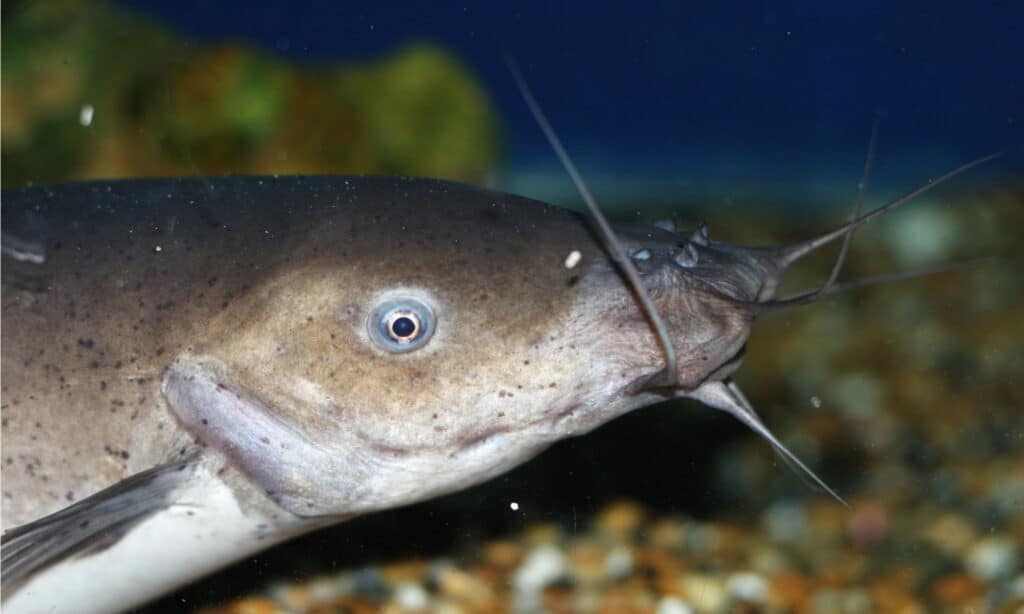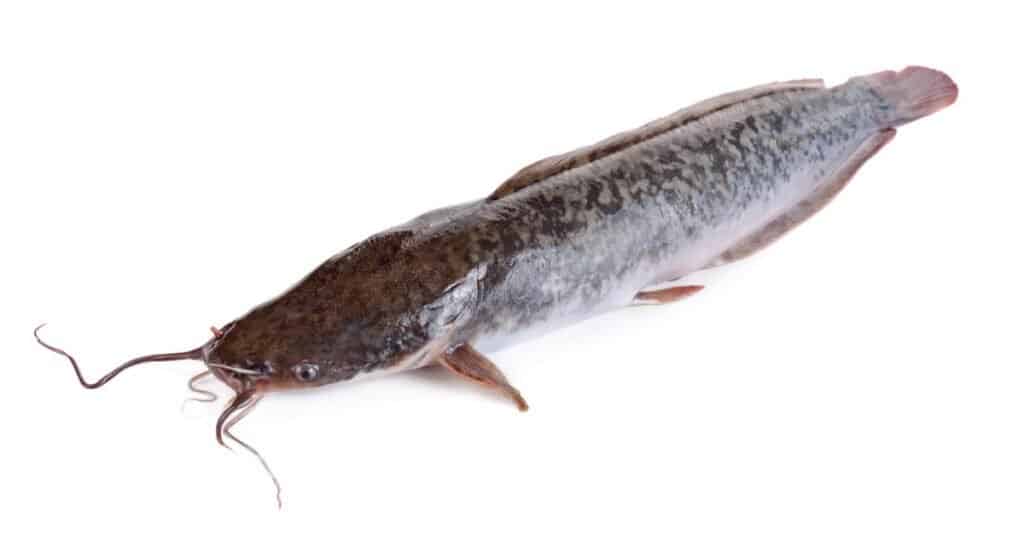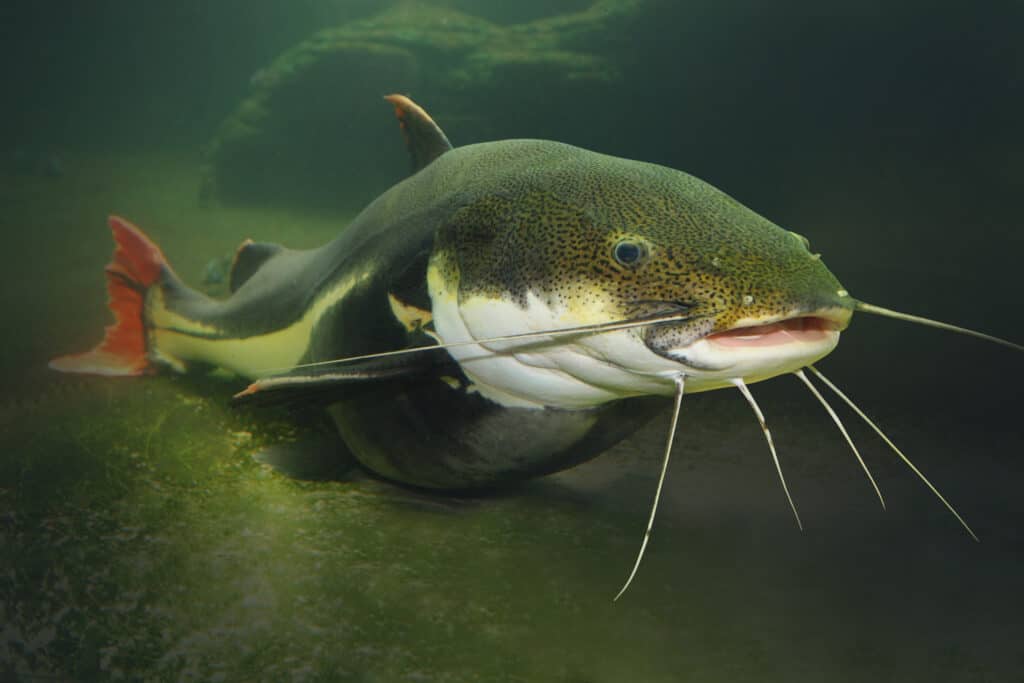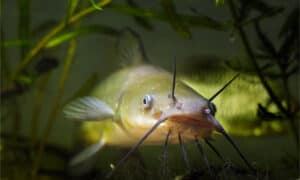
Flathead catfish are one of the many species of catfish found around the world.
©iStock.com/stammphoto
Varied species of catfish can be found around the globe. They are divided into 33 families, 400 generas, and more than 3,000 species! From Virginia to Vienna, you can find different types of catfish.
Various species of this fish can be found on every continent, excluding Antarctica, making them a sought-after catch for anglers and professional fishers. Whether fishing in marine water, freshwater, or brackish water, you may see the small-eyed mustached fish nearby.
Have you ever gone fishing with your dad, and gotten a huge tug on your line? Did you have an intense struggle to reel in a fighting catfish? They are fighters, and it’s possible, even for amateur fishermen, to catch a huge one! So have you ever wondered … what is the biggest catfish ever caught?
Let’s take a stab at answering that question. What is the world record for flathead catfish — the largest ever caught and measured? Read on to find out.
The Catfish: Are Not All Created Equally

Catfish are recognizable by the barbels on their faces.
©IrinaK/Shutterstock.com
Catfish are some of the most incredible fish with the most variety. They are easily recognized by the barbels (whiskers) on their face, which helps them sense their environment. The most diverse collections are found in South America, Asia, and Africa, but various species are prevalent everywhere.
They can range from teeny tiny, like the Pencil Catfish that reaches about a centimeter at maturity to one of the largest, the wels catfish, weighing up to 440 pounds at full maturation. They’re voracious eaters who will consume a diverse diet and grow to incredible sizes.
Catfish are popular for anglers, but one must be cautious when hunting and handling this polliwog. Did you know about half of these species are venomous?! Half! Some may even prove fatal, while many will get away with only stings from boney and sharp spines.

The catfish can discharge a shock of up to 400 volts to defend itself and capture prey.
©Pavaphon Supanantananont/Shutterstock.com
There are some exciting catfish out there, like the electric catfish of the Nile river. A large one of these guys could stun a human with up to 300-400 volts! Guides along the river will adamantly advise wearing shoes in the water.
Catfish have evolved to do all sorts of things, even walk and talk! The striped Raphael catfish or “talking catfish” make audible sounds using their spines, but a walking catfish?
The walking catfish uses its pectoral fins as arms to move along on land through wet and dry places. This catfish can also breathe out of the water to aid in survival during droughts or the like. Although not native to the U.S., it has become an invasive species, breeding quickly.

The walking catfish can actually move across land using its pectoral fins.
©Mr.Nakorn/Shutterstock.com
Catfish: An Ancient Fish
Catfish have been around for centuries. It is even believed that they were around back in the Cretaceous Period, with the dinosaurs.
A giant catfish fossil was found in the Wadi Al-Hitan Desert southwest of Cairo, Egypt, back in 2017. The Catfish, named Qarmoutus hitanensis, is believed to have lived about 37 million years ago!
Surprisingly, paleontologists said that although the fossil is millions of years old, the catfish has remained basically the same, anatomically. Qarmoutus hitanensis was measured at about 6.5 feet, comparing it to today’s Mekong and Wels Catfish.
The Catfish: Known For Resistance
Despite the size of the catfish, they are known for being, let’s say, challenging. In 2015 an Italian fisherman named Dino hooked an 8 foot 9 inch Wels Catfish weighing 280 pounds in Italy’s Po River, a popular place for fishing for massive catches.
Dino spent 40 minutes trying to reel in this giant Catfish, probably thinking that it could prove to be the biggest catfish ever caught! Eventually, he got the fish to shore, took a few photos then freed the catfish to live out the rest of its days. Pro fishers say even an 11-pound catfish will make you break a sweat when bringing them to the surface.
The Catfish: World Record Catch Mekong Catfish

The largest catfish ever caught was 646 pounds! It was a Mekong giant catfish.
©Kletr/Shutterstock.com
The world record for the biggest catfish ever caught was a flathead catfish called a Mekong catfish. These giant catfish live in the dusky waters of the Mekong River in Southeast Asia. In 2005 a man caught a Mekong catfish of 9 feet, weighing 646 pounds, taking the world record for the biggest catfish in the world.
Although breaking the record for the largest catfish ever caught was quite a feat for the angler, the story is a bit sad. Mekong catfish are critically endangered and threatened by habitat degradation and the building of dams along the Mekong River.
In this case, the villagers intended to sell the fish to environmental groups. Unfortunately, the fish died before they were able. Instead, the villagers split up the fish for food, feeding their community for several weeks.
Still, this Mekong catfish is not only the largest catfish ever caught, but the largest fish living exclusively in freshwater, and an experience that that village will never forget.
Where Is the Mekong River Located on a Map?
The Mekong River is Asia’s third-longest river and the twelfth-longest river in the world. Its headwaters are in the Tibetan Plateau and it flows through Cambodia, southwest China, Laos, Myanmar, Thailand, and the south of Vietnam. It’s called the Lancang River in China.
Thank you for reading! Have some feedback for us? Contact the AZ Animals editorial team.








